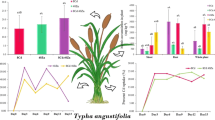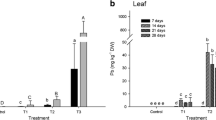Abstract
Aquatic macrophytes are known to remove trace metals from surrounding water. In the present study, an attempt was made to evaluate the phytofiltration capacity of Hydrocharis morsus-ranae and to show competition between cobalt (Co) and nickel (Ni) for the better understanding of metal bioaccumulation in the species. In a laboratory experiment, H. morsus-ranae was exposed to separate (single) and binary solutions of these metals: Ni 10.7, 18.7, 32.7, 57.1, and 100 (μg L−1); Co 5.33, 9.32, 16.3, 28.6, and 50.0 (μg L−1); and 10.7 Ni + 5.33 Co, 18.7 Ni + 9.32 Co, 32.7 Ni + 16.3 Co, 57.1 Ni + 28.6 Co, 100 Ni + 50.0 Co (μg L−1). The content of Co and Ni in the plant increased with the increasing concentration in the growth medium. Competition between the metals was seen during uptake in binary solutions. Ni interfered with the accumulation of Co, resulting in a lower Co content than in plants cultivated in Co solutions. A particularly high Co content (up to 155 mg kg−1 dry weight [d.w.]) and high efficiency of Ni uptake (Bioaccumulation Factor (BF) 2572–7239) makes the species a very good accumulator of these metals. The high content of both trace metals in plant tissues (up to 511 mg kg−1 d.w. Ni and 155 mg kg−1 d.w. Co) did not affect its growth, indicating tolerance of these toxicants. The plant showed excellent ability in removing Co (up to 98.6% in solution with 5.33 μg L−1 Co) and Ni (up to 91.4% in solution with 57.1 μg L−1 Ni and 28.6 μg L−1 Co) from nutrient solution. The results suggest that H. morsus-ranae may be useful for the phytoremediation of water bodies contaminated with Co and Ni.


Similar content being viewed by others
References
Ali H, Khan E, Sajad MA (2013) Phytoremediation of heavy metals—concepts and applications. Chemosphere 91:869–881
Appenroth KJ, Krech K, Keresztes A, Fischer W, Koloczek H (2010) Effects of nickel on the chloroplasts of the duckweeds Spirodela polyrhiza and Lemna minor and their possible use in biomonitoring and phytoremediation. Chemosphere 78:216–223
Axtell NR, Sternberg SPK, Claussen K (2003) Lead and nickel removal using Microspora and Lemna minor. Bioresour Technol 89:41–48
Babovic N, Drazic G, Djordjevic A, Mihailovic N (2010) Heavy and toxic metal accumulation in six macrophyte species from fish pond Ecka. Republic of Serbita BALWOIS – Ohrid, Republic of Macedonia, 25–29 May 2010
Barker AV, Pilebam DJ (2007) Handbook of plant nutrition. CRC Press Taylor & Francis Group, Boca Raton
Bharti S, Banerjee TK (2012) Phytoremediation of the coalmine effluent. Ecotoxicol Environ Saf 81:36–42
Borcard D, Gillet F, Legendre P (2011) Numerical ecology with R. In: Springer science+business media. LLC, New York
Borisev M, Pajevic S, Stankovic Z, Krstic B (2008) Macrophytes as indicators and potential remediators in aquatic ecosystems: a case study. Large Rivers 18(1–2):107–115
Brooks RR (1998) Plants that hyperaccumulate heavy metals: their roles in phytoremediation. microbiology. archaeology. mineral exploration and phytomining. CAB International, Oxon
Buta E, Paulette L, Mihaiescu T, Buta M, Cantor M (2011) The influence of heavy metals on growth and development of Eichhornia crassipes species. Cultivated in contaminated water. Not Bot Horti Agrobo 39(2):135–141
Buta E, Torok A, Csog A, Zongo B, Cantor M, Buta M, Majdik C (2014) Comparative studies of the phytoextraction capacity of five aquatic plants in heavy metal contaminated water. Not Bot Horti Agrobo 42(1):173–179
Catling PM, Mitrow G, Haber E, Posluszny U, Charlton WA (2003) The biology of Canadian weeds: 124. Hydrocharis morsus-ranae L. Can J Plant Sci 83:1001–1016
Cegłowska A, Sokołowska K, Samecka-Cymerman A, Kolon K, Jusik S, Kempers AJ (2016) Copper and zinc in Elodea canadensis from rivers with various pollution levels. Ecol Indic 67:156–165
Chen C, Huang D, Liu J (2009) Functions and toxicity of nickel in plants: recent advances and future prospects. Clean 37(4–5):304–313
Chorom M, Parnian A, Jaafarzadeh N (2012) Nickel removal by the aquatic plant (Ceratophyllum demersum L.). Int J Environ Sci Dev 3(4):372–375
Dhir B, Sharmila P, Pardha Saradhi P (2009) Potential of aquatic macrophytes for removing contaminants from the environment. Crit Rev Env Sci Technol 39:754–781
Dojlido JR (1995) Chemia wód powierzchniowych. Wydawnictwo Ekonomia i Środowisko, Białystok
Dytham C (2011) Choosing and using statistics: a biologist’s guide, 3rd edn. A John Wiley & Sons, Ltd., Publication, Chichester
El Falaky AA, Aboulroos SA, Saoud AA, Ali MA (2004) Aquatic plants for bioremediation of waste water. Eighth International Water Technology Conference, IWTC8 2004, Alexandria, Egypt
Engin MS, Uyanik A, Cay S (2017) Investigation of trace metals distribution in water. Sediments and wetland plants of Kızılırmak Delta. Turkey. Int J Sediment Res 32:90–97
Fuentes I, Espadas-Gil F, Talavera-May C, Fuentes G, Santamaría JM (2014) Capacity of the aquatic fern (Salvinia minima Baker) to accumulate high concentrations of nickel in its tissues, and its effect on plant physiological processes. Aquat Toxic 155:142–150
Gałczyńska M, Bednarz K (2012) Influence of water contamination on the accumulation of some metals in Hydrocharis morsus-ranae L. J Elem 1:31–41
Gilbert RO (1987) Statistical methods for environmental pollution monitoring. Van Nostrand Reinhold Company Inc., New York
Gomes MAC, Hauser-Davis RA, de Souza AN, Vitória AP (2016) Metal phytoremediation: general strategies, genetically modified plants and applications in metal nanoparticle contamination. Ecotoxicol Environ Saf 134:133–147
Gomółka E, Szaynok A (1997) Chemistry of water and air. University of Technology Press, Wrocław in Polish
Homer FA, Morrison RS, Brooks RR, Clemens J, Reeves RD (1991) Comparative studies of nickel, cobalt, and copper uptake by some nickel hyperaccumulators of the genus Alyssum. Plant Soil 138:195–215
Kabata-Pendias A (2010) Trace elements in soils and plants, fourth ed. CRC Press, Boca Raton, London, New York, Washington
Kapur A, Chopra RH (1989) Effects of some metal ions on protonemal growth and bud formation in the moss Timiella anomala grown in aseptic cultures. J Hattori Bot Lab 10:283–298
Karla YP (1998) Handbook of methods for plant analysis. CRC Press Taylor & Francis Group, Boca Raton
Maleva MG, Nekrasova GF, Bezel VS (2004) The response of hydrophytes to environmental pollution with heavy metals. Russ J Ecol 35(4):230–235
Mishra VK, Tripathi BD (2008) Concurrent removal and accumulation of heavy metals by the three aquatic macrophytes. Bioresour Technol 99:7091–7097
Parnian A, Chorom M, Jaafarzadeh N, Dinarvand M (2016) Use of two aquatic macrophytes for the removal of heavy metals from synthetic medium. Ecohydr Hydrobiol 16:194–200
Pilon-Smits EAH, Quinn CF, Tapken W, Malagoli M, Schiavon M (2009) Physiological functions of beneficial elements. Curr Opin Plant Biol 12:267–274
Polechońska L, Samecka-Cymerman A (2016) Bioaccumulation of macro- and trace elements by European frogbit (Hydrocharis morsus-ranae L.) in relation to environmental pollution. Environ Sci Pollut Res 23:3469–3480
Polechońska L, Samecka-Cymerman A, Dambiec M (2017) Changes in growth rate and macroelement and trace element accumulation in Hydrocharis morsus-ranae L. during the growing season in relation to environmental contamination. Environ Sci Pollut Res 24:5439–5451
Prasad MNV (2007) Aquatic plants for phytotechnology. In: Singh SN, Tripathi RD (eds.) Environmental Bioremediation Technologies. Springer, Berlin, Heidelberg, New York, pp 259–274
Prasad MNV, Strzałka K (2002) Physiology and biochemistry of metal toxicity and tolerance in plants. 1st ed. Springer Science+Business Media Dordrecht
Rezania S, Taib SM, Din MFM, Dahalan FA, Kamyab H (2016) Comprehensive review on phytotechnology: heavy metals removal by diverse aquatic plants species from wastewater. J Hazard Mater 318:587–599
Samecka-Cymerman A, Kempers AJ (2001) Concentrations of heavy metals and plant nutrients in water. Sediments and aquatic macrophytes of anthropogenic lakes (former open cut brown coal mines) differing in stage of acidification. Sci Total Environ 281(1–3):87–98
Skinner K, Wright N, Porter-Goff E (2007) Mercury uptake and accumulation by four species of aquatic plants. Environ Pollut 145:234–237
Skwierawski A, Skwierawska M (2013) The role of Hydrocharitetum morsus-ranae in shaping the chemical composition of surface waters. Pol J Environ Stud 22(6):1825–1833
Sooksawat N, Meetam M, Kruatrachue M, Pokethitiyook P, Nathalang K (2013) Phytoremediation potential of charophytes: bioaccumulation and toxicity studies of cadmium, lead and zinc. J Environ Sci 25(3):596–604
StatSoft Inc. (2014) STATISTICA (data analysis software system). version 12. www.statsoft.com
Török A, Gulyás Z, Szalai G, Kocsy G, Majdik C (2015) Phytoremediation capacity of aquatic plants is associated with the degree of phytochelatin polymerization. J Hazard Mater 299:371–378
Tutin TG, Heywood VH, Burges NA, Moore DM, Valentine DH, Walters SM, Webb DA (1980) Flora Europaea. Cambridge University Press, Cambridge
Upadahyay AR, Tripati BD (2007) Principle and process of biofiltration of Cd. Cr. Co. Ni & Pb from tropical opencast coalmine effluent. Water Air Soil Pollut 180:213–223
Wetzel RG (2001) Limnology. Lake and river ecosystems, 3rd edition. Academic Press, London UK
Xu Q, Fu Y, Min H, Cai S, Cheng G (2012) Laboratory assessment of uptake and toxicity of lanthanum (La) in the leaves of Hydrocharis dubia (Bl.) Backer. Environ Sci Pollut Res 19:3950–3958
Zhao F, Xi S, Yang X, Yang W, Li J, Gu B, He Z (2012) Purifying eutrophic river waters with integrated floating island systems. Ecol Eng 40:53–60
Zhu B, Ellis MS, Fancher KL, Rudstam LG (2014) Shading as a control method for invasive European frogbit (Hydrocharis morsus-ranae L.). PLoS One 9(6):984–988
Funding
This research was supported by Narodowe Centrum Nauki (PL) (Grant no. 2012/07/N/NZ8/00164).
Author information
Authors and Affiliations
Corresponding author
Ethics declarations
Conflict of interest
The authors declare that they have no conflict of interest.
Additional information
Responsible editor: Elena Maestri
Rights and permissions
About this article
Cite this article
Polechońska, L., Samecka-Cymerman, A. Cobalt and nickel content in Hydrocharis morsus-ranae and their bioremoval from single- and binary solutions. Environ Sci Pollut Res 25, 32044–32052 (2018). https://doi.org/10.1007/s11356-018-3181-x
Received:
Accepted:
Published:
Issue Date:
DOI: https://doi.org/10.1007/s11356-018-3181-x




